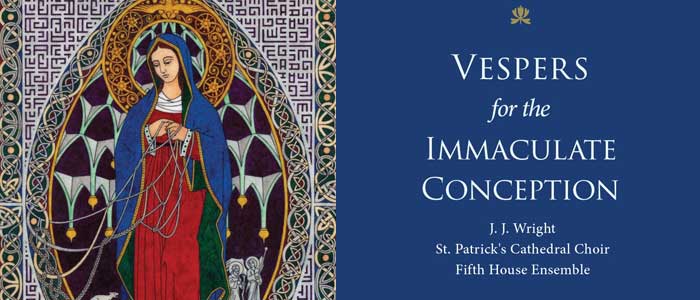Sponsored content from Ignatius Press by J.J. Wright.
Ever since I began studying sacred music, I have tried to better understand how church musicians today can be informed by the best musical techniques and spiritual aims from the long tradition of Catholic sacred music.
When I was writing and recording my album Vespers for the Immaculate Conception I tried to capture this practice by creating a dialogue between my own writing with that of Gregorian chant, and the sacred music of the Italian baroque found in the Salve Regina of Giacomo Carissimi and the Magnificat of Marc-Antoine Charpentier. I then took this music and combined it with jazz, the music from my own background, and wove it all together to create a Vespers that doesn’t sound how you might expect.
In the same way that we read the Gospel or writings of Saints from the past in search of spiritual wisdom for our lives today, we can uncover new insights and wisdom that are embedded in music from the past. In my own journey, music has always been one of the ways that God has invited me more deeply into relationship.
When I first encountered sacred music, I was enraptured by the sounds of such intense and beautiful proclamation of prayers that I had been saying since I was a child. I discovered that if I listen to a particular piece enough times, the prayers start to take on a fuller meaning, and I can then start to wonder why the composer decided to set those particular words with that music. In this way, composers of sacred music take on the role of a preacher or theologian and help us unpack the fullness of spiritual mysteries.
How to pray with Sacred Music
The important thing when learning to pray with sacred music is familiarity – the process is similar to learning a new language, but in really small doses.
Each piece becomes its own world for meditating on the ways in which a particular prayer can be illuminated for us. This can happen in the ideas that the music spurs or the particular feelings that the music evokes in us.
For me, this type of meditation works best when I can be totally focused on listening to the music and free from other distractions. I might spend a couple days or weeks praying with a particular piece, and some pieces I have come back to over and over again for years.
When I discover a new piece that I want to know better, I’ll listen to it and take it in as it is. After I listen, I might try to find a copy of the words and a translation, if it’s in a different language, and listen again with the text in front of me. While I’m doing this second listen, I try to store away in my memory how sections of the piece go and build associations to the words I’m reading and hearing. Once I establish a certain level of familiarity with the words and melodies, I can enter into the piece again like it’s the first time I’m hearing it and allow my imagination to meet God through the arrangement of the words and melodies.
Give it a try yourself with some of the music from the album below.
The track below is from J.J. Wright’s new album “Vespers for the Immaculate Conception”, available from Ignatius Press – you can pick up a copy here.
Apple Music: https://music.apple.com/us/album/vespers-for-the-immaculate-conception/1482040177
Spotify: https://open.spotify.com/artist/6qIg747XLd3pbCCkk49m7b?si=cpwXxjm-QZCRe_MOhf7nOg


